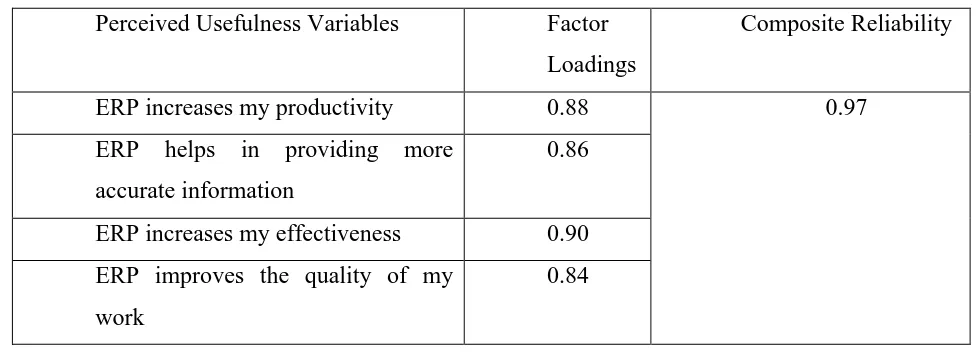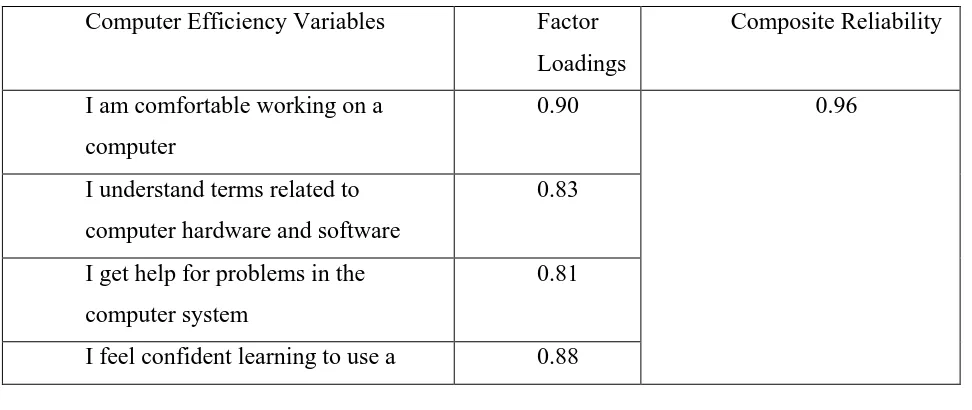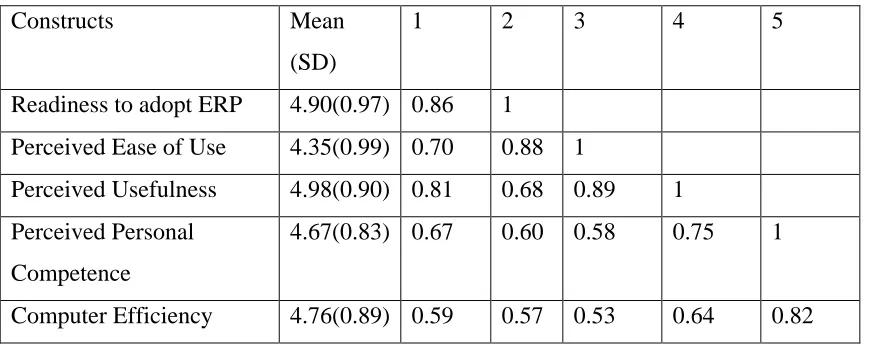EMPLOYEES’ READINESS TO ADOPT ERP SYSTEMS IN SMALL AND
MEDIUM SCALE INDUSTRIES
Dr. P. Vanishree, CVR College of Engineering,
Ibrahimpatan, India.
ABSTRACT:
The paper examines the impact of perceptions of the employees and computer efficiency on readiness of
the employees to adopt ERP systems in small and medium-sized enterprises (SMEs). In carrying out the
study, random sampling technique was used to select 200 employees who have worked at least 3 years in
an SME. Relevant data were collected using structured questionnaire. The correlation analysis was used
to test the hypothesis. The findings showed that Perceived Ease of Use, Perceived Usefulness, Perceived
Personal Competence and Computer Efficiency have a positive influence on the employee’s readiness to
adopt ERP systems. This paper suggests strategies which top management of SMEs can implement to
encourage its employees in adopting ERP systems.
Key words: ERP systems, Perceptions, Readiness to adopt.
Introduction:
SMEs have to bring about continuous improvement of business processes and business process
reengineering. This requires an integration of all the departments in the corporations. ERP system helps
SMEs to achieve this integration and also helps them to integrate with their clients.ERP system integrates
all the business functions together into one single integrated system with a single central database. This
system serves the information needs of all the departments while allowing them to communicate with
each other. Though the cost of an ERP system is very high, it becomes insignificant in the face of the
benefits a proper ERP implementation provides in the long run (Sadagopan, 1999). For SMEs to survive
critical to involve these employees to ensure that the strategies as well as the tools are relevant to their
occupation, to improve productivity. An effective business strategy for an SME centers on efficient use of
information technology and for this reason the ERP systems has emerged as enterprise backbone of the
organization (Nash, 2000). An ERP system streamlines processes within a company and improves its
efficiency and provides a means to enhance competitive performance, increase responsiveness to
customers, and support strategic initiatives (Chaterji, N.1999). The technology acceptance model (TAM),
developed by Davis, F., et al., (1989), is one of the most widely used and influential models in the field of
information systems, technology and services. TAM has been widely utilized by several researchers to
understand the factors that determine technology acceptance and usage (Adams,et al., 1992; Anakwe, et
al., 2000; Chau P., et al., 2002). Technology Acceptance Model (TAM) forms the foundation of the
conceptual model for this study. Technology Acceptance Model postulated that the intention to use
technology is determined by individual perception of its usefulness, perception of its ease of use, personal
competence and computer efficiency. The government and policy makers must provide more support to
the SMEs by helping its employees to adopt the ERP systems (Michael Sanja Mutongwa, et. al., 2013). A
deeper understanding of the ERP implementation at SMEs is needed to ensure a strong impact.
Literature Review:
With the near saturation in the large enterprise market, ERP vendors are looking to tap the potential in the
SME segment (Davenport, 1999).ERP implementation in SMEs is picking up fast. But most of this
implementation has not yet witnessed the expected results (Gargeya et al., 2005). Premkumar (2003)
holds that incremental project costs prevent or inhibit the final adoption of IT in small firms. While Indian
SMEs usually overlook the benefits of ERP citing ERP software being beyond their budgets as the reason,
it is beyond doubt that ERP implementation can improve a company's performance manifold (Parijat
Upadhyay and Pranab K. Dan, 2009). Despite the fact that usage of IT in SMEs is much below its
potential, they are now slowly waking up to the importance of adoption of ERP in their operations and are
realising the necessity of setting up intra- and inter-office networks (Federici, T. 2009). Indian SMEs are
willing to invest in IT to improve their output and efficiency (Sharma K.M. and Bhagat R., 2006). These
small and medium enterprises have realised that to maximise the potential of available information
technology, ERP solution must be implemented in tandem (Gupta A., 2000). Considering the current
arrange and assimilate all systems of entering data and processes, but also understand and adapt to
retailers' business requirements and thus respond faster and frequently to product orders from retailers
(Rao, S. ,2000).
Through proper ERP integration, SMEs can expect far-reaching results like reduced working capital
requirements and improved customer service (Leon A., 1999). They can also reduce purchase costs
considerably and bring in more clarity and accountability throughout the organization (Garg
Venkitakrishnan, 2006). Implementation of ERP in SMEs will not only act as a complete business
software solution, but will also help them to expand their reach of business quickly. The benefits that an
SME derives in the long run are comparatively more than the costs incurred while implementing an ERP
system (Nicolaou, A. 2004).
One of the main reasons why ERP applications fail is non-cooperation of employees or users who either
do not understand the products capabilities or consider it to be a threat to their jobs (Kale P. T., Banwait
S. S., Laroiya S. C., 2007). The best of the application would be a failure if the employees are not
embedded into the entire process and properly communicated with the aims and goals of the venture.
Motivated and involved employees will share their knowledge freely with the implementers and ensure
that the end result is splendid (Soja, 2006). Maintaining a level of motivation among the employees
through the entire process of ERP implementation and keeping the team together united and concentrated
till results are on the table is a challenging task. “Ease of use” is anchored to individual differences’
variables and general belief, as well as previous hands-on experience with computer/software in general
(Venkatesh, 2000). Ease of use is a very important predictor of both the adoption and continued use of a
technology that will permit organizations to reap the promised benefits (Ramayah, 2006). Aladwani
(2001) has provided a first process-oriented approach for facing the complex social problems of workers’
resistance to ERP. Employees’ perception of the perceived usefulness, ease of use of the technology, and
the users’ level of intrinsic involvement all affect their intention to use the technology ( Kwasi
Amoako-Gyampah, 2007)
Objective of the study:
1. To study the impact of Perceived personal competence on readiness to adopt ERP System
3. To study the impact of Perceived ease of use readiness to adopt ERP System
4. To study the impact of Computer efficiency readiness to adopt ERP System
Sample Design:
The present study was carried out in Hyderabad city by selecting employees from 10 Small and Medium
Scale industries. A sample of 200 employees was selected for gathering primary data. To carry out the
study in a more accurate and easier way, convenience sampling method was adopted.
Data Collection:
Both primary and secondary data have been used to draw appropriate conclusions. The primary data was
collected by using interview and questionnaire method. The secondary data was mainly drawn from
available literature pertaining to the field of knowledge.
Statistical tool used:
The researcher used the statistical package for social sciences. Factor analysis was used to test the
construct validity within each factor. Karl Pearson’s Coefficient of correlation was computed to find out
the degree of relationship among Perceived Ease of Use, Perceived Usefulness, Perceived Personal
Competence, Computer Efficiency and readiness to adopt ERP system.
Analysis and interpretation:
H1: Perceived Ease of Use has a positive effect on readiness to adopt ERP System
H2: Perceived Usefulness has a positive effect on readiness to adopt ERP System
H3: Perceived Personal Competence has a positive effect on readiness to adopt ERP System
H4: Computer Efficiency has a positive effect on readiness to adopt ERP System
Table 1: Factor Analysis of Perceived Ease of Use
Perceived Ease of Use Variables Factor
Loadings
Learning ERP is easy 0.82 0.95
ERP is clear and understandable 0.85
Easy to be skillful at using ERP 0.89
There is flexibility in operating ERP 0.84
It is easy to remember ERP
operating system
0.82
The above table shows that there are positive loadings on all the Perceived Ease of Use variables. Easy
learning, clear and understandable, flexibility in operating ERP, easy in being skillful at using ERP, easy
in remembering ERP operating system, are the factors that influence the Perception on Ease of Use of
ERP system. Perceived Ease of Use has emerged as a separate factor with an eigen value of 2.62. The
[image:5.612.46.536.386.562.2]above table shows that the variable “Easy to be skillful at using ERP” has got the highest loading of 0.89.
Table 2: Factor Analysis of Perceived Usefulness
Perceived Usefulness Variables Factor
Loadings
Composite Reliability
ERP increases my productivity 0.88 0.97
ERP helps in providing more
accurate information
0.86
ERP increases my effectiveness 0.90
ERP improves the quality of my
work
0.84
The above table shows that there are positive loadings on all the Perceived Usefulness variables. Increase
in productivity, provision of more accurate information, increase in effectiveness, increase in the quality
of work, are the factors that influence the Perception on Usefulness of ERP system. Perceived Usefulness
has emerged as a separate factor with an eigen value of 2.65. The above table shows that the variable
Table 3: Factor Analysis of Perceived Personal Competence
Perceived Personal Competence
Variables
Factor
Loadings
Composite Reliability
My work is challenging and exciting 0.80 0.90
My job is very demanding 0.75
My job makes important
contributions to the larger aims of
the organizations
0.82
I participate in decisions regarding
my job
0.78
The above table shows that there are positive loadings on all the Perceived Personal Competence
variables. Challenging and exciting work, demanding job, importance of the job, participation in decision
making and competency, are the factors that influence the Perception on Personal Competence in using
ERP system. Perceived Personal Competence has emerged as a separate factor with an eigen value of
2.55. The above table shows that the variable “My job makes important contributions to the larger aims of
[image:6.612.51.537.501.706.2]the organization” has got the highest loading of 0.82.
Table 4: Factor Analysis of Computer Efficiency
Computer Efficiency Variables Factor
Loadings
Composite Reliability
I am comfortable working on a
computer
0.90 0.96
I understand terms related to
computer hardware and software
0.83
I get help for problems in the
computer system
0.81
variety of programs
I have a clear understanding of the
three stages of Data processing i.e.
input, processing and output
0.87
The above table shows that there are positive loadings on all the Computer Efficiency variables.
Comfortability in working on a computer, understanding computer hardware terms and software terms,
getting help for problems in the computer system, confidence in learning computer programs, clear
understanding of data processing, are the factors that influence Computer Efficiency in using ERP system.
Computer Efficiency has emerged as a separate factor with an eigen value of 2.64. The above table shows
[image:7.612.62.498.365.540.2]that the variable “I am comfortable working on a computer” has got the highest loading of 0.90.
Table 5: Means, standard deviations, and correlations among study variables
Constructs Mean
(SD)
1 2 3 4 5
Readiness to adopt ERP 4.90(0.97) 0.86 1
Perceived Ease of Use 4.35(0.99) 0.70 0.88 1
Perceived Usefulness 4.98(0.90) 0.81 0.68 0.89 1
Perceived Personal
Competence
4.67(0.83) 0.67 0.60 0.58 0.75 1
Computer Efficiency 4.76(0.89) 0.59 0.57 0.53 0.64 0.82
The correlation matrix given in the above table reveals that the readiness to adopt ERP system is
positively associated with Perceived Ease of Use, Perceived Usefulness, Perceived Personal Competence
and Computer Efficiency. All the four constructs were significantly related to Readiness to adopt ERP (r
= 0.88, p < 0.01; r = 0.68, p < 0.01; r = 0.60, p < 0.01; r=0.57, p<0.01) for Perceived Ease of Use,
Perceived Usefulness, Perceived Personal Competence and Computer Efficiency respectively.
From this paper, it can be concluded that to effectively implement ERP system it is essential for the top
management to understand the perceived ease of use, perceived usefulness, perceived personal
competence and computer efficiency of its employees. The key to successful implementation of ERP
system is to first recognize the readiness of the employees to adopt ERP system. Perceived Ease of Use,
Perceived Usefulness, Perceived Personal Competence and Computer Efficiency have been found to be
positively associated with the readiness of the employees to adopt ERP systems. Top management can
encourage adoption of ERP systems by employees by ensuring that everyone gets involved in the ERP
implementation and is made accountable. Adequate time must be provided to the employees so that they
can devote time towards ERP implementation while performing their regular jobs. It is also important to
make process changes while implementing ERP so that process can be streamlined with ERP systems.
Adoption improves when employees are allowed to tweak the system to better fit their jobs. Continuous
improvement is required to take advantage of all the functions in the ERP system. Effective feedback
mechanisms also need to be in place to channel any concerns the employees may have and to take any
relevant actions to address issues that surface which can be achieved using techniques such as regular
interviews and surveys.
References:
[1]Adams, D.A, Nelson R.R., & Todd, P.A., (1992), Perceived Usefulness, Ease of Use and Usage of
Information Technology; a Replication. MIS Quarterly, Vol. 16, pp 227-247
[2]Aladwani,A.(2001), Change management strategies for successful ERP implementation. Business
Process Management Journal, 7(3), pp 266-275.
[3]Kwasi Amoako-Gyampah, (2007), Perceived usefulness, user involvement and behavioral intention:
an empirical study of ERP implementation, Computers in Human Behavior, 23(3), pp. 1232–1248
[4]Anakwe, U.P, Igbaria, M. & Anandarajan, M. (2000), Technology Acceptance in the Banking Industry;
A perspective from a low developed country. Information Technology and People. 13(4), pp 298-312
[5]Chaterji, N. (1999), ERP: Imperatives for Success. Mc.GrawHill Publishing Ltd., 1999
[6]Chau P., and Hu P., (2002), Examining a model of Information Technology Acceptance by Individual
[7]Davenport, T.H. (2000), Mission Critical: Realizing The Promise Of Enterprise Systems. Harvard
Business School Press. Boston, MA
[8]Davis, F., Bagozzi, R., Warshaw, P., (1989), User acceptance of computer technology: A comparison
of two theoretical models.Management Science 35 (8), pp. 982–1003.
[9]Federici, T. (2009), Factors influencing ERP outcomes in SMEs: a post-introduction assessment.
Journal of Enterprise Information Management, 22(1/2), pp. 81-98.
[10]Garg Venkitakrishnan, (2006), ERP Concepts and Practice, Prentice Hall India.
[11]Gargeya,V., and Brady,C. (2005), Success and failure factors of adopting SAP in ERP system
implementation. Business Process Management, 11(5), pp. 501-518.
[12]Gupta A., (2000), Enterprise resource planning: The emerging organizational value systems.
Industrial Management & Data Systems, Vol. 100 (3), pp. 114-18.
[13]Kale P. T., Banwait S. S., Laroiya S. C., (2007), Review of Key Performance Indicators of Evaluation
of Enterprise Resource Planning System in Small and Medium Enterprises. XI Annual International
Conference of Society of Operation Management, India.
[14]Leon A., (1999), ERP Demystefied, Tata McGraw Hill
[15]Michael Sanja Mutongwa & Kefa Rabah (2013), ERP System Solutions for Small and Medium
Enterprises In Trans Nzoia County – Kenya. Journal of Emerging Trends in Computing and Information
Sciences, 4(11), November, 2013, pp. 869-876.
[16]Nash, K.S. (2000), Companies don’t learn from previous IT snafus. Computer World, 34(44), pp.
32-33.
[17]Nicolaou, A. (2004), Quality of post implementation review for enterprise resource planning systems.
International Journal of Accounting Information Systems, 5(1), pp. 25-49.
[18]Parijat Upadhyay and Pranab K. Dan (2009), ERP in Indian SME’s: A Post Implementation Study of
the Underlying Critical Success Factors. International Journal of Management Innovation System, 1(2),
[19]Premkumar, G. (2003), A meta-analysis of research on information technology implementation in
small business. Journal of Organizational Computing and Electronic Commerce, 13(2), pp. 91-121.
[20]Ramayah, T. (2006), Interface characteristics, perceived ease of use and intention to use an online
library in Malaysia. Information Development, 22(2), pp. 123-133.
[21]Rao, S. (2000), Enterprise resource planning: business needs and technologies. Industrial
Management & Data Systems, 100(2), pp. 81-88.
[22]Sadagopan, S. (1999), ERP: A Managerial Perspective. New Delhi, India: Tata McGraw Hill.
[23]Sandberg, K.W. & Vinberg, S. (2000), Information technology and learning strategies in small
enterprises. Behaviour and Information Technology, 19(3), pp. 221–227.
[24]Sharma K.M. and Bhagat R.,(2006), Practice of information systems Evidence from select Indian
SMEs. Journal of Manufacturing Technology Management, 17 (2), pp. 199-223.
[25]Shehab,E.; Sharp, M.; Supramaniam; L. Y.; Spedding, T. (2004), Entreprise resource planning: An
integrative review. Business Process Managerial Journal. 10(4), pp. 359-386
[26]Soja, P. (2006), Success factors in ERP systems implementations: lessons from practice. Journal of
Enterprise Information Management, 19(6), pp. 646-661.
[27]Venkatesh, V. (2000), Determinants of Perceived Ease of Use: Integrating Control, Intrinsic
Motivation, and Emotion into the Technology Acceptance Model. Information Systems Research, 11(4),


